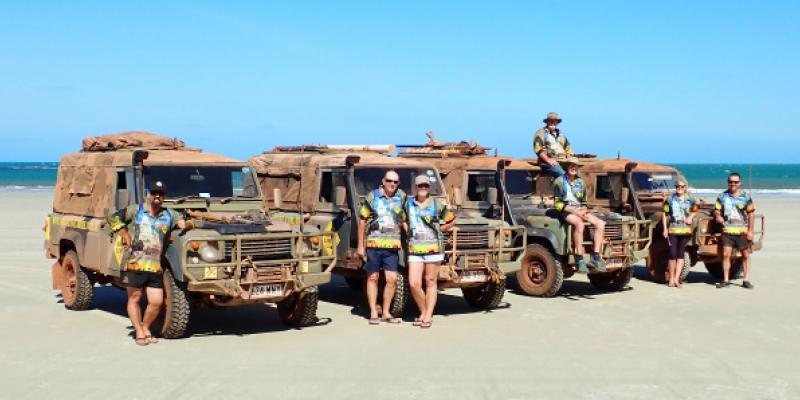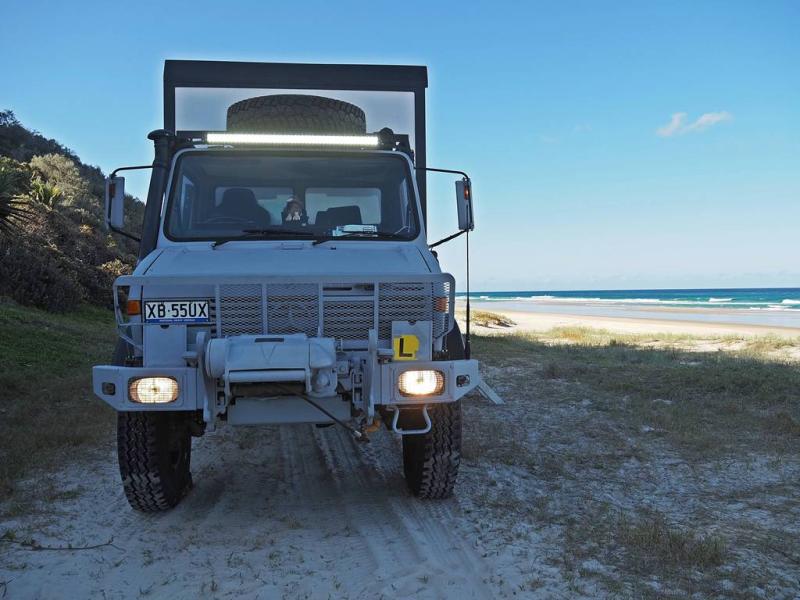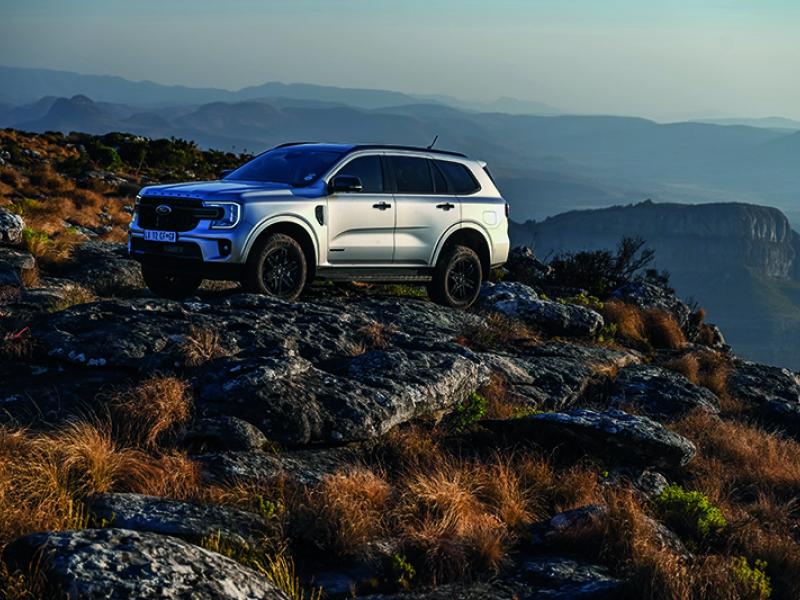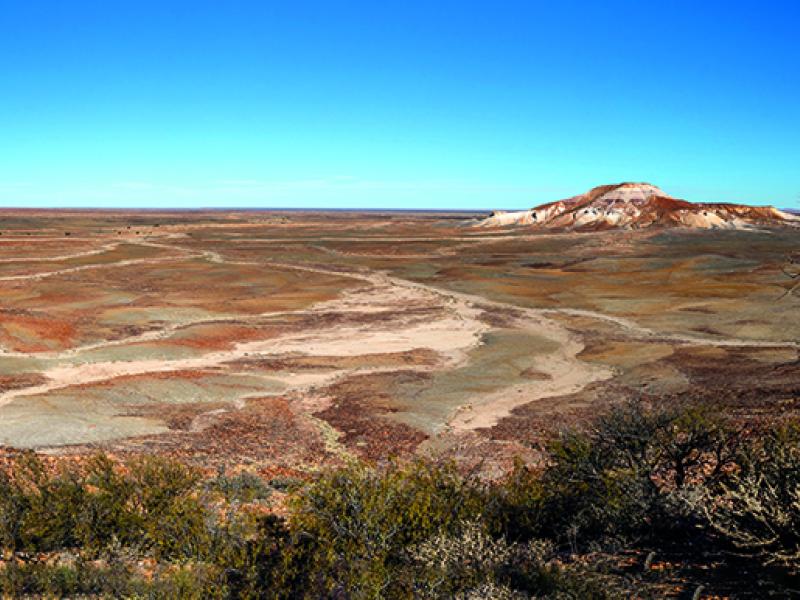Making it to Australia’s Cape York via the famed ‘Old Telegraph Rd’ is real ‘Bucket List’ stuff for most keen Kiwi FOUR-Wheelers. One, who recently turned dream into reality, was regular NZ4WD contributor, Kevin Isemonger.
I don’t know about you, but for me – at least – my journey to Cape York started over 30 years ago.
vBack in the 1980s I subscribed to an Australian 4WD magazine called ‘Overlander’. I used to read this Journal from cover to cover every month. My favourite articles were great adventures into the Australian interior – the most memorable being the trips up the legendary ‘Old Telegraph Track’ to Cape York. Names like ‘Nolans Brook’, ‘Palm Creek’, the bridge over ‘Cyprus Creek’, the Jardine River and of course ‘Gun-Shot’ were legendary for me.
Not easy!
Of course, reading about someone else doing the trip, is very different to doing it yourself. The logistics, for a start, are huge. Naturally number one was how to get there? No Rental Car company in Australia, for instance, allows any sort of ‘unsurfaced’ road driving, simply because of how extremely bad their ‘unsurfaced’ roads can be. The corrugations are so bad you will lose your dental cover off your travel insurance as they can often rattle the fillings out of your head!
Take your own vehicle? The cost of transport and compliance to land your vehicle in Australia is not way over the top – but, it is not a cost (or effort) you would want to indulge simply for a two week trip to the ‘Tip’.
Then you have the issue of exactly where to go? Yes, there are heaps of articles and websites and instructions which is marvellous IF you have the time to sort through the volumes of testosterone fuelled BS you find online.
Where to stay? ALL camping areas north of Cairns must be pre-booked. Some more popular places have ‘waiting lists,’ such is the draw of the ‘Cape’ for Australians.
There is also the issue of alcohol bans. A vast percentage of the Cape York area is owned and managed by the ‘Traditional Owners’ who – in some areas – operate very strict alcohol bans, with fines for breaches fetching well into the thousands of dollars if you wander into some areas such as Lakefield.
The entire area north of the Jardine, for instance, is a limited alcohol area where you can be stopped, and your vehicle searched.
When should you go? The rainy season starts about November and goes through to the end of May. And both the Peninsula Developmental Road (aka the PDR which runs from Lakeland in the south-east to Weipa which is roughly three-quarters of the way the western coast of the ‘Cape) and of course the Old Telegraph Track are closed.
Really closed too – with up to six metres of high-speed water over many of the crossings and the roads resembling something you’d more likely find in the Congo – where damage to closed roads must be paid for by the perpetrator.
Where is fuel available? Where can you stock up on food and water? What if I break down? The Cape York area is simply vast – very isolated – and there is definitely no cellphone coverage!
Then there is the ‘clear and present danger’ of what Australia is famous for – nearly everything is out to kill you and eat you. Where can you stop and go for a walk? And is there anywhere where can you swim safely?
Too hard?
Which, for me anyway, made it all just too hard to contemplate for the best part of those 30-or-so years. I lost interest as I simply didn’t have the time to sort all this stuff out, especially taking the whole family.
Until ... totally out of the blue, early in 2018 I received a txt from a mate in Wanaka asking if I would be interested in going on a trip up to Cape York. After a few false starts, Rod stumbled upon ‘No-Limits 4x4 Hire’ based in Cairns, and as per the name, there was ‘No-Limits’ on where you could take the vehicles – PLUS they only have ex-Australian Army Land-Rover ‘Perenties’, and best of all – they also run ‘Tagalong’ tours.
Suddenly the near impossible came down to a simple credit card transaction and all the problems went away. We booked the 15-day Cape York Tagalong in August 2018 for the following year.
‘No-Limits’ restrict the number to five customer vehicles plus the guides’ vehicle. Fellow Land Rover Series 1 owners Jackie and Colin Parr from Rotorua booked on the trip, plus Doug McKeown and John Lees from the Canterbury 4WD Club, while the other spaces were filled with two couples from Australia. As it turned out, the Australians cancelled last minute, bad luck for ‘No-Limits’ but good luck for the three remaining vehicles, as the smaller numbers made for an epic trip.
The year went really quickly, as they do when you get older – and before we knew it, we were on the plane and flying out of the Auckland rain to the tropical paradise of Cairns. We booked a flash hotel on the waterfront and we were able to pick up the Land Rover the day before kick-off, to pack.
Ready for anything
Now for those non-Land Rover faithful out there, a Land Rover Perentie is a bespoke-built vehicle for the Australian Army, so they are about as ‘nuggetty’ a vehicle as you can get. Built very tough to withstand the worst that the Australian Outback and the Army could throw at it. And believe me, despite owning both a Series 1 and a Series 3 for many years, the steering and the brakes on the Perentie took a bit of getting used to negotiating the busy Cairns roads driving back to our hotel to pack. Remember these are 2.1m high – heavy steering – taking it into a tight multi story car park. Yes it kinda’ stood out.
The ‘No-Limits’ vehicles come as a soft top 110 Defender with a four-cylinder 4.0l Isuzu diesel with the standard four-speed Range-Rover gearbox and permanent 4WD with central diff lock. They are equipped with a sleeping platform in the tray of the 110 with a very comfortable 100mm thick, vinyl covered foam squab on top, two fold out chairs, a fold out table, a good sized fridge, storage boxes – two of which are used by the guides, one for the cutlery and plates etc and a fourth for whatever extra snacks you wanted to carry.
They have two x 12vDC and two x USB ‘always on’ power outlets in the back plus a 230vAC Inverter at the back of the vehicle and two USB power outlets on the dash. Plus there are interior LED lights, a power take-off winch and recovery gear, a mosquito net and a PRS radio set for info and entertainment.
Our guides for the trip were Toby Read – owner operator – ex-National Parks Ranger (#nolimits4x4hire) and Daryl Trease – outdoorsman, cook, fisherman and general good bastard (#thebudgetbushman). Our’s was to be their third trip up to the Cape that season, plus a few other trips through the Simpson Desert, so these chaps were very experienced and knowledgeable on the geography – so where to go and what to see - as well as the flora and fauna of the region.
Off we go!
And so, on Wednesday 21 Aug 2019 we rattled our way down to the assembly point not far from the Cairns CBD where we gathered. Last minute checks and we were off – 36 years late – but better than never.
Why the journey? The history is important to the background of the Old Telegraph Track (OTT), why it exists today and why this is becoming such a huge attraction to 4WD enthusiasts around the world.
The telegraph line was originally built back in the late 1870s and went from Cooktown to Laura and onto Palmerville where Gold had been discovered in 1873.
The line was then extended from Laura in a direct and very straight line north, close on 1,000km to Cape York – reaching the tip in 1887 – and from there, island-hopped to the ‘Dutch East Indies’ – and on as a connection to the rest of the world.
Cable Bay, 18km NE of Nelson, New Zealand was the first overseas cable link to Australia, opening on 21 February 1876.
The original telegraph line was a single galvanised wire suspended between galvanised poles. Every 70 km (up to 120 km) a repeater telegraph station was built to receive the Morse code and on-send to the next telegraph station.
Most of the buildings of the telegraph stations are still there today and look the same as they did back in the day – two storey with shutters over the windows. The telegraph line was maintained by bushmen/linesmen who lived at the telegraph stations and in huts along the line. Some huts still exist – but in very poor condition.
Many of these telegraph stations still serve as accommodation for folks that have turned the old historic Government sites into ‘Roadhouses’ serving food, fuel and providing accommodation to the trucking industry that supply the many small communities on the peninsula – and now camping facilities for the very rapidly growing tourist trade.
From Cairns to Cooktown
Our tour left from Cairns and followed the original old coast road through the tropical forest of the Daintree to where the road turned to a 4WD-only track at Emmagen Creek and the very steep climb up over the Cape Tribulation/Cowie Range. Near Bloomfield we turned into the Wujal Wujal Falls before following the Bloomfield River out to our first night stop at the famous ‘Lion’s Den’ outback pub – stopping along the way to admire a freakin’ huge Croc sunbathing on the river bank – in case you were ever in doubt about the dangers of Far North Queensland.
Day 2 took us through Cooktown and north following the old gold trail/Railway/Telegraph Line up Battle Camp Road north east of Laura to the Laura Homestead – then on to Kalpowar Crossing. This stop was a superb Crocodile river – so we were informed to keep well away from the water’s edge. A great meal cooked in the camp oven on an open fire. The scene was surreal with the heat of the day dying away – the sounds of the bush – all sitting around the tables in the open was reminiscent of the old African Safari scenes.
Day three started off a bit cool until the sun woke up – and then the baking heat of the north set in. Onto more dusty roads as the fine red ochre settled and stained everything including your skin as the Land-Rover shook and rattled its way north into the heat and dust.
Joining up with the PDR
We joined the Peninsula Development Road (PDR) at Musgrave the first of many old Telegraph stations and spent the night next to the Coen River, just north of the township of Coen where we fuelled up the Land Rovers.
It was then a matter of onward north up the PDR. The Peninsula Development Road (PDR) is a Government-backed project to improve the way of life on the peninsula and to support the huge bauxite mining operation in Weipa – two thrids of the way up the peninsula on the western side. The PDR follows the Telegraph track for most of the way north.
An ‘interesting’ inclusion are road signs which simply say ‘Dip.’ At these points, the four-lane wide corrugated dust track plunges down a slope while at the same time narrowing to a single lane to cross a rough, boulder-strewn, dried up creek bed before hitting the pot-holes from hell – then bumping back up the other side back to four lanes again.
Obviously, it can get interesting meeting a three-trailered Land-Train at these pinch points!
About halfway between Archer River (Telegraph Station) Roadhouse and Morton Telegraph Station, State Highway 81 continues west to Weipa – while the PDR, at a slightly lower class of road –z continues north to our next night stop at the Moreton Telegraph Station, a wonderful oasis of cool trees next to the Wenlock River (no fuel).
From the Weipa turn-off, however, the PDR generally starts to deteriorate – dramatically. You hear about the kilometres of corrugations, but nothing prepares you for how the road literally tries to shake the vehicle to pieces
Day 5 was ‘Business Day,’ the day we hit the Old Telegraph Track. We headed onward north to the Bramwell Telegraph Station, aka Bramwell Junction. At Bramwell the land dips into a vast valley which is the catchment for the Duice River. The PDR turns east and follows the high ground, while the (now) Old Telegraph Track continues north following its most economical line.
Real 4WD-ing
First up – Palm Creek (-12.064995,142.552151). We have all seen Youtube videos of this entry point. Some say it’s to scare anyone who is not properly prepared to turn back before it’s too late – and yep, it would work. Nothing really prepares you for this sudden drop into the scoured-out canyon formed by hundreds of 4WDs cutting their way to the edge of the stream.
Now, 30+ years of clay track driving in New Zealand tells you this is going to be messy with a toboggan trip down the slope smashing into the bottom to balance on the nose for a heart-stopping second or two – but you are in for a surprise. The white slimy clay is actually like a fine rock dust, so provided it’s not raining, the surface has a lot more grip than you would think. Low first – feet off the pedals – and a nice soft decent into the trench.
Down the canyon – across Palm creek, around the slight bend – and oh sh.t. In front was a very steep climb up a very stepped bank. Second Low – hammer down – bam. Into the face I go – and up the face I go with shouts of ‘Slow Down’ from Toby. I was just about airborne off the top edge of the face. WTF?
In the same conditions in New Zealand clay you would be winching for the next 20 minutes – but not here.
Valuable lessons learned, we then spent the night in a bush camp on the Tele-track at Dulhunty River.
The next day – early – we hit the notorious Gun-shot creek – but here it was the same deal as Palm Creek, there was actually tonnes of traction; as long as you knew how to drive a 4WD off road, it was really easy.
We then (briefly) met the PDR again as it crosses the OTT from east to west as we continued straight north for a swim at Fruitbat Falls then on to the Twin Falls of Elliot Creek for the end of the sixth day of our trip.
Seven Days
Day 7 we crossed more iconic creeks – Canal, with its canal water channel through the rock, Cypress with the Cypress tree bridge, then on to Nolan’s Brooke where we witnessed the drowning of a Nissan and two Toyota Prados in the space of a hour. Aussies just don’t know how to drive through water!
The track takes a sudden turn south west after Nolans, as it is illegal to cross the Jardine. After the Crocodiles became protected in 1972, the population has increased significantly to where they are rapidly becoming a problem.
We enjoyed the $AUD100 three minute Jardine Ferry crossing before driving onto our beach-front reserved camping spot at Loyalty Beach – about an hour’s drive from the ‘Tip’
Day 8 was a ‘Tourist Day’ visiting Pajinka – the northern most point of the Australian continent – Sumerset Beach, the old northern capital (which was moved to Thursday Island in 1877) before heading down ‘Five Beaches’ then back to Loyalty Beach.
Day 9 was a ‘Free-day’ when we caught a boat out into the Torres Straight to visit Thursday and Horn Islands. Incidentally, it is a 1.5 hour flight to Cairns from Horn Island – but just a 20 minute hop to Papua New Guinea.
Day 10 was a rest day, so we went for a brief drive that afternoon out to the west coast towards the Jardine River mouth.
Homeward bound
Day 11 was the day we started our journey home following the PDR back to Fruitbat Falls for lunch – but staying on the PDR and headed east out to the Coral Sea to Captain Billys Landing in Shelburne. This was an open, storm-lashed place with a constant wind – with the highlight seeing bat caves swarming with the little airborne mammals.
Day 12 we re-joined the PDR back to Bramwell and onto Morton for a quick shower before hitting the Frenchman’s Track. We stayed the night on the banks of the Wenlock – albeit well back from the water’s edge.
The next day we crossed the Wenlock and the Pascoe without incident before heading on to Lakeland, Portland, Chilly Beach and back to a bush camp at Cook’s Hut for the night.
Day 14 was a big (driving) day from Cook’s Hut back to the PDR and south to Coen where we turned off the PDR and onto the Port Stewart Road before crossing the Stewart River to follow the Lillyvale Road (stunning) back to Musgrove on the PDR and onto Hann River Telegraph Station for the night.
Day 15 was our last day and was a direct drive to Cairns, stopping off to view the largest concentration of pre-historic rock art in the world at ‘Split-Rock’ near Laura.
And there you go. Obviously, I have just scratched the surface but I am already (well! Ed) over my story word quota and I wanted to include much more info into this article, so Ross has kindly allowed me to post a link to the videos of the trip on my Youtube channel ‘Kevz110’ - https://www.youtube.com/watch?v=rV6oOpDrai4&t=4s
‘No-Limits’ bookings are full for 2020, but I guess if the demand is there, perhaps the company could arrange another trip – but the vehicles are available to hire. For more info on the company and its Cape York tours their website is https://nolimits4x4hire.com.au/cape-york-4x4-tagalong-tours/







